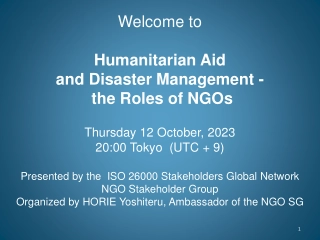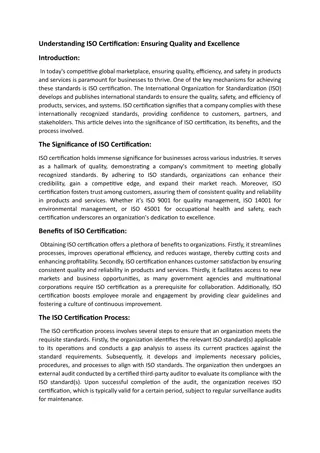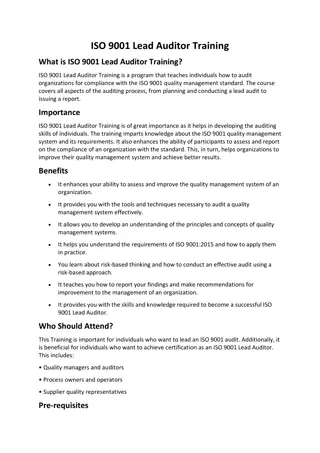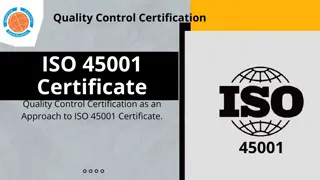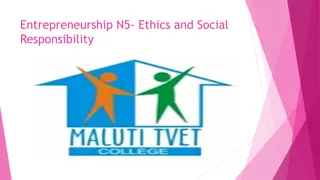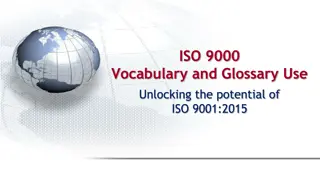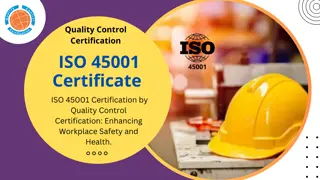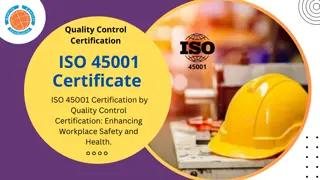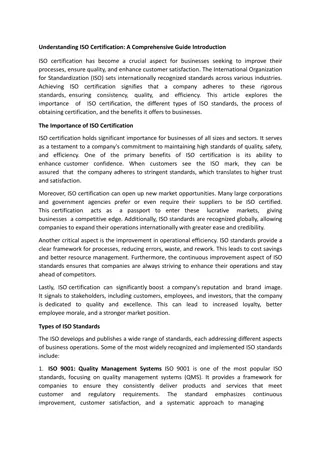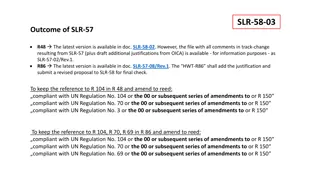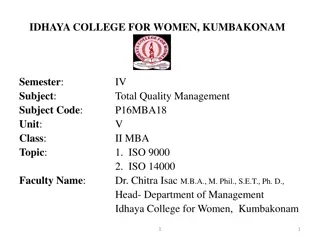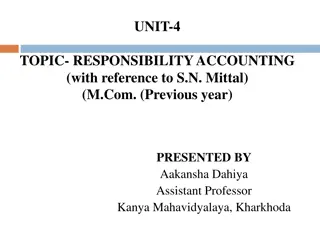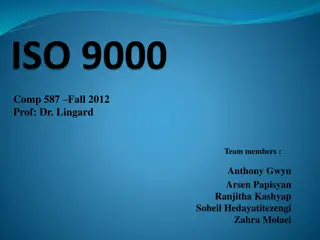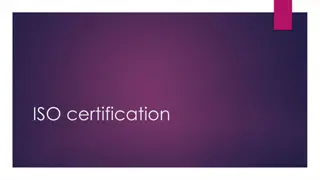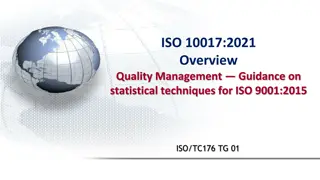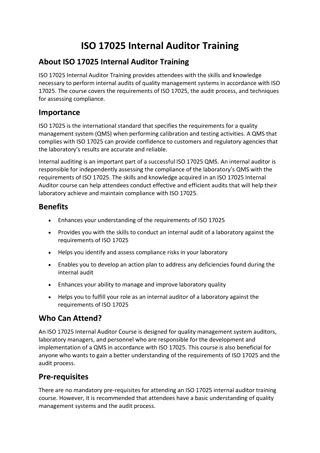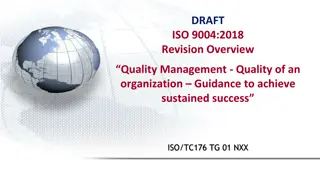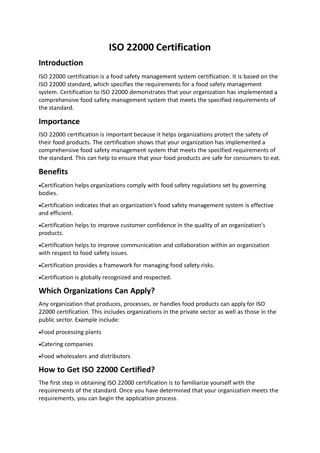Understanding ISO 26000: Key Guidance on Social Responsibility
ISO 26000 is an International Standard that offers guidance on improving social responsibility within organizations to contribute to sustainable development. It is versatile, non-certifiable, and aimed at enhancing operating processes through responsible behavior. The standard's credibility stems from its adaptability to diverse contexts, flexibility for user customization, and its development via international consensus with a multi-stakeholder approach.
- ISO 26000
- Social Responsibility
- Sustainable Development
- Organizational Guidance
- International Standard
Download Presentation

Please find below an Image/Link to download the presentation.
The content on the website is provided AS IS for your information and personal use only. It may not be sold, licensed, or shared on other websites without obtaining consent from the author. Download presentation by click this link. If you encounter any issues during the download, it is possible that the publisher has removed the file from their server.
E N D
Presentation Transcript
ISO 26000 Basic training material Published by ISO 26000 Post Publication Organisation (PPO) Contact: Tina.Bohlin@sis.se (PPO Secretary) or Staffan.Soderberg@amap.se (PPO Vice Chair, part of the drafting team), Drafting team part of the ISO 26000 PPO stakeholder advisory group: Ms. Carolyn Schmidt (leader), Ms. Adriana Rosenfeld, Ms. Divya Kirti Gupta, Mr. Ken-Ichi Kumagai Version: March 15, 2016
INTRODUCTION 1. About this presentation 2. About ISO 26000 3. The core content 4. How to use ISO 26000
1. About this presentation Basic introduction to ISO 26000, Guidance on Social Responsibility: emphasizes key definitions and main points provides an overview, not a complete summary presents a starting point for further exploration and use Intended for people and organizations from all sectors of their societies, and from any region of the world Open source, free of charge, available to anyone to use, and to customize to fit their own context and needs
How to use this presentation It is recommended to translate these slides into your local language, consulting the formal translation of ISO 26000:2010 It is recommended to add slides that are relevant to the target audience. Examples of such slides can be based on the local/regional/national/international context as well as illustrating sectors, networks, tools, initiatives etcetera. Annex A contains initiatives and tools. It is not recommended to delete any of the slides as they form a context It is recommended that you format the slides to fit your purposes, for example by adding illustrations and photos that you have developed/own. examples of voluntary
2. About ISO 26000 ISO 26000 is an International Standard giving guidance/recommendations about how any organization can improve its Social Responsibility and thus contribute to sustainable environmental, social and economic development. ISO 26000 is not certifiable, as it does not contain requirements. Its appeal is to those who, for whatever reasons, seek to improve their operating processes and impacts through socially responsible behaviour. ISO is the world s largest developer of voluntary International Standards, used by businesses and other organizations; its members are national standards bodies and its standards and name-recognition are global in reach. See Appendix for more information about ISO.
What makes ISO 26000 important and credible? It is designed to work in all organizational and cultural contexts in any country or region It is flexible and the user decides how to use it It was internationally negotiated through ISO s consensus method, using a multi-stakeholder approach, and balance to reflect global diversity. See Appendix for more information about this process, and the different stakeholder groups. It incorporates the real-life experiences of its many contributors, and at the same time builds on international norms and agreements related to Social Responsibility
Examples of linkages between International norms and ISO 26000 UN Global Compact; UN Declaration of Human Rights ILO GRI Global International Labour Org. Reporting ISO 26000 UN Working Group on Business & Human Rights UN Sustainable Developme nt Goals OECD Guidelines
How does ISO 26000 define Social Responsibility? Social Responsibility (SR) is the responsibility of an organization for the impacts of its decisions and activities on society and the environment through transparent and ethical behaviour that: Contributes to sustainable development, including the health and welfare of society Takes into account the expectations of stakeholders Is in compliance with applicable law and consistent with international norms of behavior, and Is integrated throughout the organization and practised in its relationships.
SR definition, continued Note 1: Activities include products, services and processes. Note 2: Relationships refer to an organization s activities within its sphere of influence. (Sphere of Influence refers to the range of relationships through which the organization has the ability to affect the decisions or activities of others that is, its owners, customers, workers, suppliers, etcetera.) Sustainable development is about meeting the needs of society while living within the planet s ecological limits and without jeopardizing the ability of future generations to meet their needs. Sources: ISO 26000: 2010 Clause 2:18; Clause 3.3.5
What does ISO 26000 offer to its users? Guidance and recommendations on how to structure, evaluate, and improve their social responsibility, including stakeholder relationships and community impacts. Provides organizations with a set of societal expectations of what constitutes responsible behaviour, based on authoritative international instruments
ISO 26000 can be used by any organization, for example: large multi-national corporations small and medium size enterprises the public sector (hospitals, schools or others) foundations, charities and NGOs extractive industries, such as mining and fossil fuel companies service and financial industries (banks, IT, insurance) municipal governments farmers and agribusiness consultancies
ISO 26000 Social Responsibility can show a commitment to continual improvement attract like-minded partners, investors, customers and staff improve relations with employees, communities, the media, suppliers, and government agencies help to establish more robust, stable supply chains contribute to sustainable development by reducing harmful environmental, social and economic impacts help manage and reduce risks identify new opportunities
Increasing social responsibility contributes to a virtuous cycle where each action strengthens the organization and the community, encouraging sustainable development Loyalty of workers and customers Good community relations Fair operating practices
3. The core content Seven principles Seven core subjects and their related issues Stakeholder engagement
The 7 Principles 1. Accountability 2. Transparency 3. Ethical behaviour 4. Respect for stakeholder interests 5. Respect for the rule of law 6. Respect for international norms of behavior 7. Respect for human rights
Accountability and Transparency Accountability answerable for decisions and activities to the organization s governing authorities and, stakeholders (those who are affected by its actions) is the: state of being legal bodies, broadly, more its Transparency is openness about decisions and activities that affect society, the economy and the environment, communicate these timely, honest and complete manner and a willingness clear, to in accurate, Source: ISO 26000:2010 Clause 2.1 and 2.24
Accountability taking policies and Transparency for involve and responsibility decisions Accountability and transparency involve the top decision-makers, as well as everyone throughout a chain of command Leaders need to know and acknowledge who has made what specific decisions
Principle of Ethical Behaviour Ethical behaviour involves deciding what is the right course of action, day to day Ethical behavior is defined as behaviour that is in accordance with accepted principles of right or good conduct in the context of a particular situation Ask yourself: your knowledge? would you be comfortable if were to become actions public Source: ISO 26000:2010 Clause 2.7
Principle of Respect for stakeholder interests This involves identifying groups of stakeholders - those who are affected by your decisions and actions - and responding to their concerns. It does not mean letting them make your decisions. Note that, by definition, social responsibility is not decided in a vacuum; it always involves reference to the guiding principles, and awareness of impacts on others
Principle of Respect for the rule of law In the context of social responsibility, respect for the rule of law means that an organization complies with all applicable laws and regulations .even if they are not adequately enforced. Source: ISO 26000:2010 Clause 4.6
Principle of Respect for international norms of behaviour In situations where the law or its implementation does not provide for adequate environmental or social safeguards, an organization should strive to respect, as a minimum, international norms of behaviour. International norms of behavior are derived from customary international law, generally accepted principles of international law, or intergovernmental agreements that are universally or nearly universally recognized. These can be found in authoritative international instruments from organizations such as the United Nations, International Labour Organization (ILO). Sources: ISO 26000:2010 Clause 2.11 and 4.7
Principle of Respect for human rights ISO 26000 urges its users to identify the vulnerable populations among its stakeholders, and to work to ensure their fair treatment ..In situations where human rights are not protected, take steps to respect human rights and avoid taking advantage of these situations Source: ISO 26000:2010 Clause 4.8
In summary, the 7 Principles: Establish the underlying framework for socially responsible decision-making Link each user of ISO 26000 to a global community of those who share the principles Emphasize that Social Responsibility is a process that develops and evolves with practice
The 7 Core Subjects Holistic Integrated Approach Community Involvement and Development Human Rights Organizational Consumer Issues Labour Practices Organization Governance The Fair Operating Practices Environment Interdependence
The 7 core subjects Each of the 7 core subjects is relevant to every organization and should be considered. Users then review specific issues (37 in all) listed under each core subject to identify those issues that are relevant and significant. Not all of the 37 specific issues will be relevant to each user. Cross-cutting considerations appear in all the 7 core subjects: economic aspects health and safety the value chain gender balance communication with stakeholders See Appendix for the complete list of issues for each Core Subject
Core subject: Organizational governance Leaders should practice and promote ethical behavior, accountability and transparency ISO 26000 suggests tools for integrating SR into core organizational decisions Some specific issues for SR improvement: Develop incentives for performance on social responsibility Adjust organizational structure to include third-party review of sensitive areas such as financial management, etc. Create ways to track decisions and their implementation, to ensure accountability and follow- through Implement processes for meaningful (two-way) communication with stakeholders
Core subject: Human rights ISO 26000 encourages users to identify and respond to members of vulnerable groups within their sphere of influence Users should avoid complicity; that is, avoid assisting those abusing others, and avoid benefiting directly from abuses committed by someone else Some specific issues for SR improvement: develop mechanisms for due diligence : ways to identify, address and prevent actual or potential human rights damage resulting from your activities examine the treatment of vulnerable groups in your context, such as: indigenous peoples, girls and women, those historically discriminated against on the basis of race, ethnicity or religion, people with disabilities, the elderly, migrants, etc. provide remedy and grievance procedures
Core subject: Labour practices Everyone should be able to earn a living wage through freely chosen work (not forced labor or slavery) All workers should experience just and favorable conditions at work Responsibility goes beyond workplaces that an organization owns or directly controls Some specific issues for SR improvement: Eliminate child labour and forced labour (*) Comply with laws and regulations on the rights of unions and collective bargaining, and social protection (medical coverage, disability leave, etc. (*) Eliminate discrimination in hiring and dismissals (*) (*) These are recognized as basic human rights (ISO 26000:2010, 6.3) Understand and control the health and safety risk involved in activities; provide safety equipment and training Consider the impact on workers family lives when making scheduling decisions Avoid contracting with suppliers or sub-contractors who use unfair or abusive labour practices, including child labour
Core subject: Environment Some specific issues for SR improvement: Prevent pollution; reduce emissions of pollutants into the air, water and soil as much as possible Practice green procurement evaluate suppliers of goods and services on their environmental impacts Use sustainable, renewable resources whenever possible Conserve water in operations Practice life-cycle approach(including disposal) aim to reduce waste, re-use products or components, and re-cycle materials
Core subject: Fair operating practices Some specific issues for SR improvement: Practice honesty don t ask for or accept bribes; don t attempt to break laws through use of political influence Respect property rights; pay fair compensation for property you acquire or use Treat suppliers and customers/consumers fairly, including prompt payment of bills and prompt attention to problems Examine your value chain/supply chain, and be sure you are paying enough to enable your suppliers to fulfill their own social responsibilities
Core subject: Consumer issues Some specific issues for SR improvement: Protect consumers health and safety; design and test products to ensure this Reduce waste by minimizing packing material and, if appropriate, offer recycling and disposal services Eliminate or minimize negative health and environmental impacts of products and services, such as noise or waste Pay particular attention to the information needs of vulnerable individuals (for example, those with limited vision or hearing, or poor reading ability)
Core subject: Community involvement and development Actions that benefit communities - such as job creation, skill development, and provision of health, welfare and other services - should be integrated into the core business model Some specific issues for SR improvement: Consult directly with community members before designing programs Focus on increasing local procurement and hiring When investing in a community, consider the economic, social, and environmental impacts of your investment Respect the traditional uses of natural resources by local populations, especially indigenous peoples Fulfill tax and other legal responsibilities as described in law, even when punishments are not likely Consider social investment : programs and infrastructure which will improve quality of life, and which will increase the capacity of the community to develop sustainably
A note: Community involvement and development is different from philanthropy Philanthropic giving is an important element of SR use of wealth, in many cultures. However, philanthropy is basically top down (the giver decides what projects and programs to fund). SR in the ISO 26000 context should encourage reciprocity benefits and obligations for all involved rather than exalting givers and treating receivers as dependants This is also an important point for charitable organizations to keep in mind, as their recipients are also some of their stakeholders.
Stakeholder engagement and communication: a crucial component Stakeholder identification and engagement are central to addressing an organization s social responsibility. (ISO 26000:2010 Clause 5.3) Communication establishes channels for exchanging knowledge, suggestions, complaints and ideas for solutions. Identifying stakeholders and developing channels of communication with them is one of the most rewarding and most challenging parts of Social Responsibility. Start to communicate respect and willingness to engage before a crisis emerges. The goal is to build trust and credibility for the long term, not to find quick fixes for problems.
What is meant by the term stakeholder ? ISO 26000 defines a stakeholder as an individual or group that has an interest in any decision or activity of an organization. Stakeholder engagement is defined as activity undertaken to create opportunities for dialogue between an organization and one or more of its stakeholders, with the aim of providing an informed basis for the organization s decisions. Source: ISO 26000:2010, Clause 2.20; 2.21
Who are your stakeholders? Stakeholders are people or groups who are affected by the actions of your organization. Often they also have the ability to affect you. This is why ISO 26000 emphasizes stakeholder involvement, and provides suggestions on how to go about it. Stakeholder categories include workers, clients, purchasers, consumers, owners, investors, government officials, community residents, and suppliers. For example, a hospital s stakeholders could include doctors, nurses, patients, patients families, the owners of the hospital (could be a branch of government, or private investors), the community where the hospital is located, the suppliers of medical items, etc.
In order to improve organizational performance, stakeholder engagement should: Include leaders of different stakeholder groups (ex. community, workers, stockholders), and also seek to involve the broader population to ensure fairness and to obtain different viewpoints Emphasize two-way communication (listen to your stakeholders, as well as explaining yourself to them) Keep a realistic and positive tone; avoid making vague or ambitious promises that can t be kept NOT be used mainly as a vehicle for publicity or photo opportunities
4. HOW TO USE ISO 26000 Setting the direction from the top; building SR into governance and procedures Determining relevance and significance; establishing priorities: matrix, mapping, gap analysis Assessing your responsibilities in your sphere of influence Performing due diligence Reporting and other communications with stakeholders
Integrating SR throughout an organization, clause 7 Governance and operating procedures Setting direction toward SR Owners and top management need to lead Use mission and vision statements to define values Involve relevant stakeholders, including those working for the organisation Set short-term and long- term goals Incorporate transparency and accountability at all levels Apply SR to decisions on purchasing, investing, hiring and promoting, advertising, community relations, etc.
Identification of SR Issues (ISO 26000 Clauses 5.2.2, 7.3.2, 7.3.4) Every core subject, but not necessarily each issue, has some relevance for every organization. (ISO 26000, 5.2.2) The seven core subjects Organizational governance Human rights Labour practices Identifying relevant issues of SR (7.3.2.1) Determining significance (7.3.2.2) Setting priorities (7.3.4) Environment Recognizing relevant issues of SR (5.2.2) Fair operating practices Consumer issues Community involvement & development
Checklist-approach: identify issues that need improvement Related actions and expectations identified under issues Issues identified as relevant and significant: Governance: Human rights: Labour practices: Environment: Fair operating practices: 5 Consumer issues: Community Involvement and Development: Governance: 12 Human rights: 33 Labour practices: 44 Environment: 39 Fair operating practices: 29 Consumer issues: 53 Community Involvement and Development: 48 1 8 5 4 7 7 Total = 37 Total = 258
Stakeholder identification and engagement: examples Owners / Directors Suppliers Customers / Clients / Purchasers Governmental bodies Natural environment (air, land, flora, fauna, earth, water) consult with scientists, officials, local residents, NGOs, etc. Community residents Workers Full time, part time, temporary, seasonal, etc.
Who are your stakeholders? These are some questions to help you identify them. To whom does your organization have legal obligations? Who might be positively or negatively affected by your decisions or activities? Who would be disadvantaged if excluded from the engagement? Who in your value chain is affected? Who is likely to express concerns about the decisions and activities of the organization? Who can help the organization address specific impacts?
Establishing priorities 1. Describe your current situation with respect to the seven core subjects of ISO 26000 2. Identify your desired situation - specific SR improvement 3. Focus on the gaps between the two; identify the most significant issues 3 A. Identify current weaknesses and the causes behind them 3 B. Identify resources needed to overcome the weaknesses: personnel, time, money, partners, etc. 3 C. Develop a time- line and action plan to bridge the gaps
Assessing responsibilities in your sphere of influence YOUR ORGANIZATION Your customers/ clients Examine the extent to which you can have an impact. For example, how large is your market share? Your suppliers Their Their suppliers customers / clients Resources/ Raw materials Waste Disposal: re-use, recycling, trash
Due diligence investigating situations and avoiding SR risks Definition: process to identify the actual and potential negative social, environmental and economic impacts of an organization s decisions and activities, with the aim of avoiding and mitigating those impacts Examine the impacts of decisions throughout your sphere of influence Review the legal requirements and context of activities Consider the viewpoints of those impacted by your decisions your stakeholders Source: ISO 26000:2010 Clause 7.3.1
Communicating about your Social Responsibility Communicate activities on relevant issues within each of the Seven Core Subjects Use communicating and reporting as part of a continuing dialogue; be honest when you have fallen short on some of your goals Communicate to different audiences of stakeholders in appropriate and understandable ways Consider involving third parties in commenting on progress and goals
Reviewing and improving SR performance (7.4.2) Setting the direction for SR Building SR into the governance, systems and procedure (7.4.3) (7.7.2) Monitoring activities on SR (7.7.3) Reviewing the progress and performance on SR Enhancing the reliability of information and management (7.7.4) (7.7.5) Improving performance Stakeholders can play an important role in reviewing an organization s performance on social responsibility. (ISO 26000: 2010 Clause 7.7.1)
ADDITIONAL RESOURCES Sources of guidance: authoritative international instruments, and other SR tools and initiatives Claims of using ISO 26000 Where to go for more information about ISO 26000 Optional: Questions for discussion



